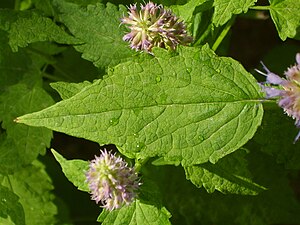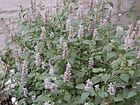Note: This is a project under development. The articles on this wiki are just being initiated and broadly incomplete. You can Help creating new pages.
Agastache scrophulariifolia - Purple giant hyssop
Korean mint, known as Agastache rugosa, blue licorice, purple giant hyssop, Indian mint, wrinkled giant hyssop, is an aromatic herb in the mint family, native to East Asia(China, Japan, Korea, Russian Primorye, Taiwan, and Vietnam).
Contents
Uses
poor digestion, fungal, abdominal bloating, indigestion, nausea, vomiting, chest congestion, Diarrhea, headaches.
Parts Used
Chemical Composition
Seasonal variations in the chemical composition of leaves fromAgastache rugosa were analyzed by gas chromatography-mass spectrometry (GC-MS). Phytotoxic and antimicrobial activities of its essential oil were investigated by characterizing 31 components, primarily methylchavicol (80.24%),dl-limonene (3.50%), linalool (4.23%), 5-methyl-2-(1-methylethylidene)-cyclohexanone (3.84%), and β-caryophyllene (2.39%)[1]
Common names
| Language | Common name |
|---|---|
| Kannada | |
| Hindi | |
| Malayalam | |
| Tamil | |
| Telugu | |
| Marathi | NA |
| Gujarathi | NA |
| Punjabi | NA |
| Kashmiri | NA |
| Sanskrit | |
| English | Agrimony |
Habit
Identification
Leaf
| Kind | Shape | Feature |
|---|---|---|
| Simple | The leaves are divided into 3-6 toothed leaflets, with smaller leaflets in between |
Flower
| Type | Size | Color and composition | Stamen | More information |
|---|---|---|---|---|
| Unisexual | 2-4cm long | Yellow | 5-20 | Flowers Season is June - August |
Fruit
| Type | Size | Mass | Appearance | Seeds | More information |
|---|---|---|---|---|---|
| 7–10 mm (0.28–0.4 in.) long pome | clearly grooved lengthwise, Lowest hooked hairs aligned towards crown | With hooked hairs | {{{6}}} |
Other features
List of Ayurvedic medicine in which the herb is used
- Vishatinduka Taila as root juice extract
Where to get the saplings
Mode of Propagation
How to plant/cultivate
Prefers a sunny sheltered position and a well-drained soil[3]
Commonly seen growing in areas
Grassy places in mountains, valleys, less stony meadows.
Photo Gallery
References
External Links
- Pages that are stubs
- Ayurvedic Herbs known to be helpful to treat poor digestion
- Ayurvedic Herbs known to be helpful to treat fungal
- Ayurvedic Herbs known to be helpful to treat abdominal bloating
- Ayurvedic Herbs known to be helpful to treat indigestion
- Ayurvedic Herbs known to be helpful to treat nausea
- Ayurvedic Herbs known to be helpful to treat vomiting
- Ayurvedic Herbs known to be helpful to treat chest congestion
- Ayurvedic Herbs known to be helpful to treat Diarrhea
- Ayurvedic Herbs known to be helpful to treat headaches
- Herbs with Leaves used in medicine
- Herbs with Seeds used in medicine
- Herbs with common name in English
- Habit - Perennial plant
- Index of Plants which can be propagated by Seeds
- Index of Plants which can be propagated by Cuttings
- Herbs that are commonly seen in the region of Grassy places in mountains
- Herbs that are commonly seen in the region of valleys
- Herbs that are commonly seen in the region of less stony meadows
- Herbs








